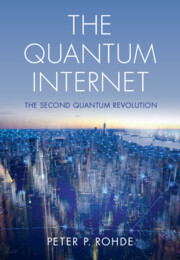Refine search
Actions for selected content:
3286 results in Quantum Physics, Quantum Information and Quantum Computation
22 - Classical Cryptography
-
- Book:
- The Quantum Internet
- Published online:
- 09 September 2021
- Print publication:
- 30 September 2021, pp 182-186
-
- Chapter
- Export citation
18 - Quantum Repeater Networks
-
- Book:
- The Quantum Internet
- Published online:
- 09 September 2021
- Print publication:
- 30 September 2021, pp 155-174
-
- Chapter
- Export citation
33 - Time Sharing
-
- Book:
- The Quantum Internet
- Published online:
- 09 September 2021
- Print publication:
- 30 September 2021, pp 255-256
-
- Chapter
- Export citation
Part VIII - Economics and Politics
-
- Book:
- The Quantum Internet
- Published online:
- 09 September 2021
- Print publication:
- 30 September 2021, pp 249-250
-
- Chapter
- Export citation
13 - State Preparation
-
- Book:
- The Quantum Internet
- Published online:
- 09 September 2021
- Print publication:
- 30 September 2021, pp 109-116
-
- Chapter
- Export citation
46 - Economic Properties of the Qubit Marketplace
-
- Book:
- The Quantum Internet
- Published online:
- 09 September 2021
- Print publication:
- 30 September 2021, pp 279-280
-
- Chapter
- Export citation
8 - Quantum Cost Vector Analysis
-
- Book:
- The Quantum Internet
- Published online:
- 09 September 2021
- Print publication:
- 30 September 2021, pp 70-74
-
- Chapter
- Export citation
References
-
- Book:
- The Quantum Internet
- Published online:
- 09 September 2021
- Print publication:
- 30 September 2021, pp 326-334
-
- Chapter
- Export citation
24 - Bitcoin and the Blockchain
-
- Book:
- The Quantum Internet
- Published online:
- 09 September 2021
- Print publication:
- 30 September 2021, pp 190-192
-
- Chapter
- Export citation
44 - Forward Contract Pricing Model
-
- Book:
- The Quantum Internet
- Published online:
- 09 September 2021
- Print publication:
- 30 September 2021, pp 276-276
-
- Chapter
- Export citation
1 - Introduction
-
- Book:
- The Quantum Internet
- Published online:
- 09 September 2021
- Print publication:
- 30 September 2021, pp 1-6
-
- Chapter
-
- You have access
- Export citation
Preface
-
- Book:
- The Quantum Internet
- Published online:
- 09 September 2021
- Print publication:
- 30 September 2021, pp xv-xvi
-
- Chapter
- Export citation
54 - The Quantum Ecosystem
-
- Book:
- The Quantum Internet
- Published online:
- 09 September 2021
- Print publication:
- 30 September 2021, pp 318-320
-
- Chapter
- Export citation
53 - Geostrategic Quantum Politics
-
- Book:
- The Quantum Internet
- Published online:
- 09 September 2021
- Print publication:
- 30 September 2021, pp 316-317
-
- Chapter
- Export citation
6 - Optical Encoding of Quantum Information
-
- Book:
- The Quantum Internet
- Published online:
- 09 September 2021
- Print publication:
- 30 September 2021, pp 45-54
-
- Chapter
- Export citation

The Quantum Internet
- The Second Quantum Revolution
-
- Published online:
- 09 September 2021
- Print publication:
- 30 September 2021
7 - Atom Interferometry
-
- Book:
- Quantum Atom Optics
- Published online:
- 23 July 2021
- Print publication:
- 05 August 2021, pp 115-129
-
- Chapter
- Export citation
1 - Quantum Many-Body Systems
-
- Book:
- Quantum Atom Optics
- Published online:
- 23 July 2021
- Print publication:
- 05 August 2021, pp 1-9
-
- Chapter
-
- You have access
- Export citation
Dedication
-
- Book:
- Quantum Atom Optics
- Published online:
- 23 July 2021
- Print publication:
- 05 August 2021, pp v-vi
-
- Chapter
- Export citation
4 - Spin Dynamics of Atoms
-
- Book:
- Quantum Atom Optics
- Published online:
- 23 July 2021
- Print publication:
- 05 August 2021, pp 44-63
-
- Chapter
- Export citation
